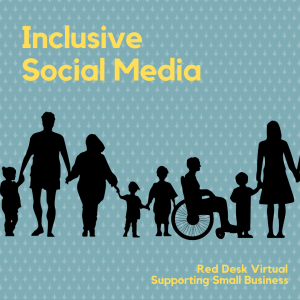Making Social Media Design More Inclusive
What does Inclusivity mean in terms of Social Media?
Finding ways to make content visually diverse and physically accessible. Viewers want to access content and will engage more if they see themselves represented in it. By having inclusive social media, it demonstrates responsible social media.
Dove work hard to promote beauty inclusiveness for all women in their Dove Real Beauty Pledge. However, what does inclusivity mean in terms of design?
 How to make your Social Media Design more Inclusive
How to make your Social Media Design more Inclusive
Dove’s strategy is just one way to make your social media more inclusive. However, there are many other ways to get your message across to different demographics such as age, gender, language and ability.
We will look at several ways to capture inclusivity by way of social media design. Inclusive design provides the best user experience for as many people possible. Providing inclusive design provides a variety of ways for users to engage with your brand and content.
4 Ways to Make Your Social Media Design Inclusive
- Text – Text should be accessible by using plain language to get your point across, limiting the use of capitals within sentences (ie DON’T WRITE IT ALL LIKE THIS), but do use capitals in hashtag phrases (ie #BlackLivesMatter) as it makes it more legible. Also, by putting hashtags and mentions at the end of your post keeps it neat and tidy
- Alt-Images – These alternative text fields (available in Facebook, Twitter, Instagram and LinkedIn) allow you to write descriptions of the images for people to visualize these when they can’t see them. Some tips include:
- Describing the content. Instead of saying “image of a tree”, expand to “a willow tree blowing in the wind”
- Don’t bother saying “image of” or “picture of” as it is obvious it is a visual if someone has clicked on it
- Is colour key to the image? Mention this in the description
- If the image is humorous, let the reader know why!
- If the image contains an important phrase or slogan, transcribe this
- It’s not just images, you can do this on GIFS too
- Captioning – Captions on videos not only help draw in viewers with hearing impairments but also those learning the language and viewers watching with the sound off. If you upload video clips to social media, try to include closed captions. For many of the social media platforms such you can write, transcribe and upload these yourself but Facebook Live and IGTV also provide Automatic closed captioning. Also, consider sections of video that don’t contain dialogue, how will you describe what is happening? You could try descriptive audio, descriptive transcript or live video transcribed.
- Colour Contrast – Think about colour contrast on your website and social media posts. Green/red or blue/yellow combinations are difficult to read. Think about where you put text on an image as the two can often fight for attention – either use a solid background or opaque overlay
Remember that if this isn’t your area of expertise, to listen to feedback from your social media community. Taking on board and reacting positively to feedback to improve your social media offerings can only be a good thing.
